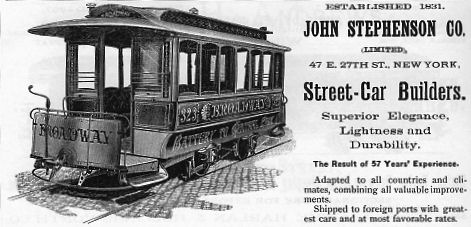John Stephenson Car Co. - Page 2
But by 1842, Stephenson could continue no longer. Like so many other car builders since, he had accepted notes and bonds from many railway customers as payment in lieu of cash, and as times worsened this “paper” became worthless. Stephenson was forced to close his shop, vowing never to build another railway car. In a way, he did keep his vow: he never again built a car for a steam railway. But he sure did build streetcars! Only a year after his failure [1843], John Stephenson was back in business and erected a new factory: a four-story building 44 feet wide by 100 feet deep, on 27th Street between Madison and 4th Avenues. This just happened to be opposite the New York & Harlem Railroad depot. {397} Two years later [1845] he would expand this facility with a six-story building 200 feet long, extending all the way through the block to 28th street. {396} There Stephenson began building streetcars for the city of New York while continuing to build wagons and omnibuses. Demand for the latter was increasing steadily. In 1846 there were reportedly 255 omnibuses in service in New York City, 376 in 1849 and 683 in 1853. By 1856, Stephenson employed 200 men in the production of 300 omnibuses a year. {15} While the omnibus market flourished, so did the horse car market. It seemed that virtually every street in the city was destined to have a horse car line. But this, of course, worked against the omnibus market. Stephenson began building cars for the 3rd Avenue line, and by 1859 was fully involved in the streetcar business. Imagine doing this kind of business in a six-story, downtown building, where raw materials had to be moved from storage on one floor to a smith shop or wood shop on another, and the finished parts moved to yet another floor for assembly; and the completed car from the erecting shop to the paint shop on yet another floor. Although these cars were tiny by today’s standards, the building’s elevator(s) obviously had to be rather large and quite busy! As in everything he undertook, John Stephenson began to improve horse car design.
White
{16}
says —
Bishop {396} says —
Stephenson is also generally credited with creating a reversible horse car: a car with the body mounted to the single bogie by means of a pivot, so that the car body could be turned on its undercarriage, thus avoiding the need for a turntable. This car appears to have been patented in 1859.
But John Prentice points out that Stephenson’s Patent No. 26,626 (27 December 1859) in fact does not cover the whole vehicle, but just a braking system for reversible cars that could be operated from the driver’s seat no matter in which direction the body was facing. The lack of a claim for the basic idea clearly indicates that such cars were already being built, but “hitherto ... made without brakes or so that the brakes could be used only in one direction.” [Quote from Stephenson’s patent.] Stephenson may indeed have created the concept. We’ll never know. But he did not have a patent on it! So far, we have found 18 U.S. Patents issued to, or assigned to, John Stephenson. We’re sure there must be a lot more. Here’s our list. If you know of others, please share them with us.
In 1860, Stephenson produced his first fare-box, or bobtail, car—built for one-man operation—according to the design of John B. Slawson. This was an extremely lightweight car that became very popular. By 1883, Stephenson claimed more than half of all American street railways were running fare-box cars. He subsequently hired Slawson, whose patents became a valuable asset of the Stephenson firm. During the Civil War Stephenson supplied the Union Army with gun carriages and pontoons. By 1867, fifty-eight year old John Stephenson was ready to begin to enjoy the fruits of his years of labor. The firm—heretofore a sole proprietorship—was reorganized as the John Stephenson Company, and several of Stephenson’s associates were taken in as partners. As the 1870s dawned, business was booming, and John Stephenson began building himself a lavish estate. The writer of a vanity biography of American businesses [407] published in 1876, but copyrighted in 1874, and probably reflecting information gathered at least a year before, extolled the Stephenson firm thusly —
But the halcyon days of the post Civil War period were about to come to an end. In September of 1876 the bottom fell out of the stock market; businesses began to fail. Railroads—steam and street as well—had no money for cars: even those already ordered. John Stephenson must have felt déjà vu all over again. The expenditures on his lavish estate and of his philanthropies left him strapped for cash, with little hope of further business: he had to ask his creditors for an extension of his notes, but then had to suspend payment altogether. He overcame this by forming a joint stock company {424}—the John Stephenson Company Limited—and paying off most of his creditors in stock.
Between 1876 and 1891 Stephenson reportedly built some 25,000 streetcars for the U.S. and abroad, including a full line of single and double trucks for street railway service. In 1878, the Stephenson works had orders for London; Paris; Port Adelaide, Australia; Lima, Peru; St. Petersburg, Russia; Hull, Swansea and Liverpool, England; Bahia, Brazil; Berlin; Jalapa, Mexico; Amsterdam, Holland; Wellington, New Zealand; Christiana, Norway; Rio de Janeiro; Hamburg and a score of other places. {14} Continued
|


